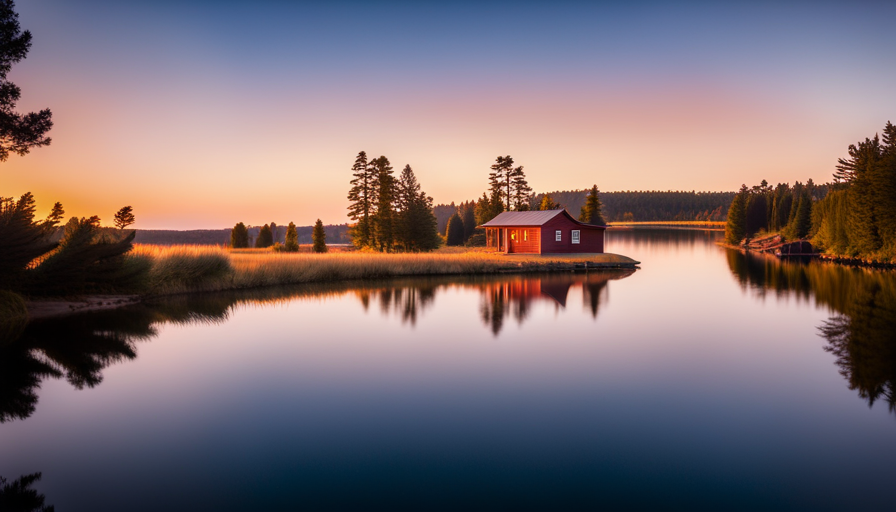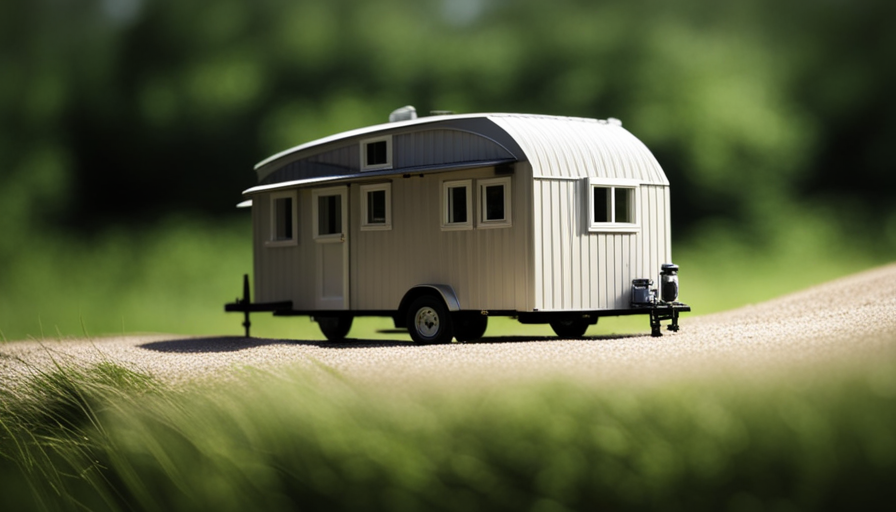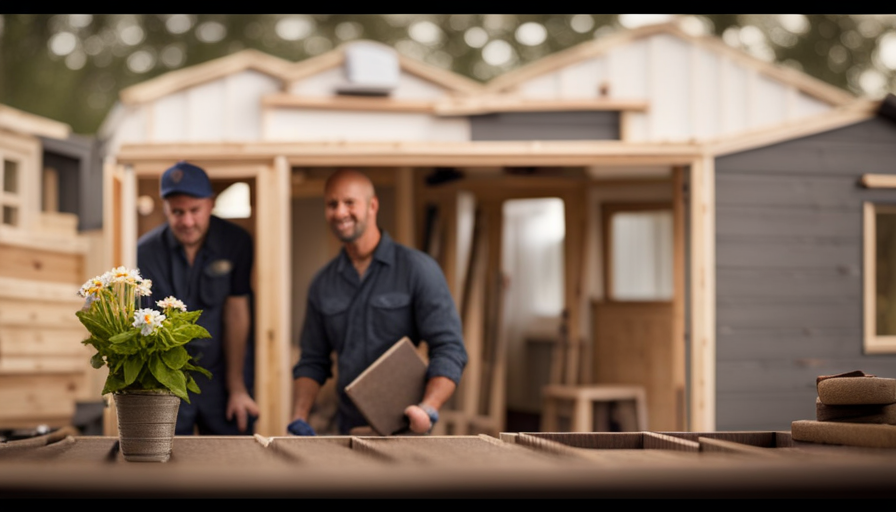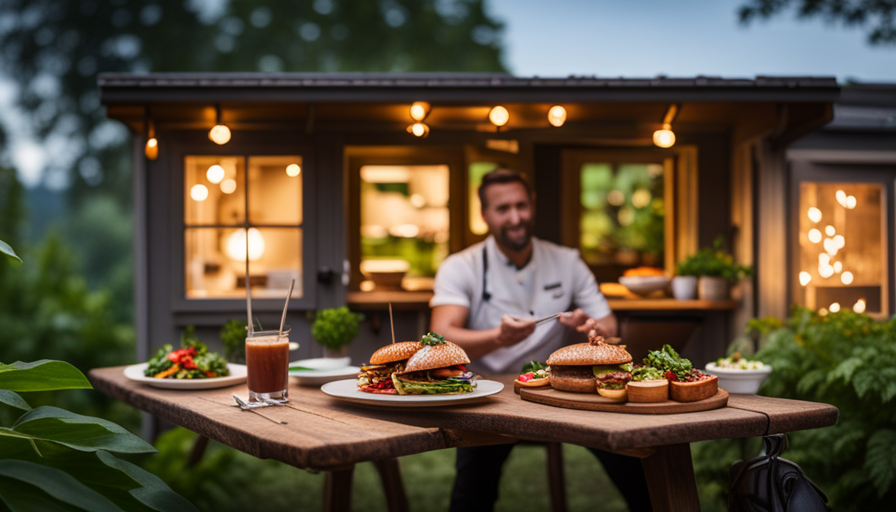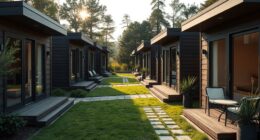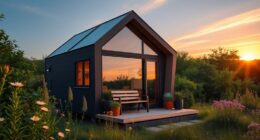Where can a tiny house be parked in Minnesota?
This question may arise for those seeking an alternative and affordable housing option in the Land of 10,000 Lakes. As a resident of Minnesota, I understand the challenges of finding suitable parking for tiny homes.
In this article, I will explore various options and provide valuable insights to help you navigate the complexities of zoning laws, community regulations, and available resources in the state. From tiny house communities and RV parks to private land rentals and building your own community, there are several avenues to explore.
Additionally, I will delve into temporary parking options, alternative housing programs, off-grid living possibilities, and the importance of consulting with professionals. By engaging with the community and advocating for tiny house living, you can find a place to call home for your tiny house in Minnesota.
Key Takeaways
- Options for parking tiny houses in Minnesota include tiny house communities, RV parks, private land rentals, and building your own community.
- It is important to consult with professionals and understand variances and local ordinances for parking a tiny house.
- Temporary parking options and alternative housing programs can provide solutions for those looking to park their tiny homes.
- Off-grid living and remote locations, such as state forests and national wildlife refuges, can also be considered for parking tiny houses in Minnesota.
Understanding Zoning Laws and Regulations
Do you want to know where you can park your tiny house in Minnesota? Well, let’s dive into understanding the zoning laws and regulations.
When it comes to finding a place for your tiny house, it’s important to understand variances and navigate local ordinances. Variances are exceptions to the zoning laws that allow you to park your tiny house in areas that may not typically allow it. To obtain a variance, you usually need to demonstrate that your tiny house meets certain criteria, such as size and design.
Navigating local ordinances is also crucial, as different cities and counties may have their own regulations regarding tiny house parking. By researching and understanding these laws, you can find suitable locations for your tiny house in Minnesota.
Now, let’s explore the options of tiny house communities and RV parks.
Tiny House Communities and RV Parks
There are charming communities nestled in the serene landscapes of the North Star State that welcome tiny houses with open arms. If you’re looking for a place to park your tiny house in Minnesota, consider exploring the following options:
-
Tiny House Communities: There are a few tiny house communities in Minnesota that offer designated parking spots for tiny homes. These communities often have shared amenities and a sense of community.
-
RV Parks: Many RV parks in Minnesota also allow tiny house parking. These parks may have specific regulations and guidelines for tiny houses, so be sure to inquire about their policies.
-
Campgrounds: Some campgrounds in Minnesota allow tiny house parking. These campgrounds usually offer a more rustic experience and may have limited amenities.
-
State and National Parks: Certain state and national parks in Minnesota have designated areas for RVs that may also accommodate tiny houses.
-
County Fairgrounds: Some county fairgrounds in Minnesota have RV parking areas that can be used for parking tiny houses.
When it comes to parking your tiny house, private land rentals can also be a great option. These rentals often offer more flexibility and freedom in terms of zoning and parking regulations.
Private Land Rentals
When it comes to finding a place to park my tiny house in Minnesota, I’ve found that searching for landowners open to tiny house rentals is a great option. Utilizing online platforms for land rentals has also been helpful in my search.
Additionally, considering lease agreements and utilities is important to ensure a smooth rental process.
Search for Landowners Open to Tiny House Rentals
Seek out landowners in Minnesota who are keen on hosting tiny house tenants. When searching for landowners open to tiny house rentals, it’s important to understand their requirements as landlords. Start by reaching out to landowners who’ve expressed interest in renting out their property or are open to alternative housing options.
Once you find potential landowners, negotiate rental terms that work for both parties. Discuss the duration of the rental agreement, rent amount, and any additional conditions or restrictions. It’s crucial to have a clear understanding of the responsibilities of both the tenant and the landlord. Remember to be professional and respectful throughout the negotiation process.
By finding landowners who are open to hosting tiny houses, you can create a mutually beneficial arrangement. Transitioning into the next section about utilizing online platforms for land rentals, you can expand your search and find more opportunities.
Utilize Online Platforms for Land Rentals
Take advantage of online platforms where landlords across the state can connect with potential tenants, opening up a world of possibilities for finding the perfect plot of land to park your cozy little home.
Land sharing websites like Landshare and Hipcamp allow landowners to offer their properties for rent, providing an excellent opportunity for tiny house owners to find suitable locations in Minnesota. These platforms provide a wide range of options, from secluded rural properties to urban lots, allowing you to choose the setting that best suits your needs.
Additionally, crowdfunding options such as Tiny House Parking and Help Get Sited can help you raise funds to secure a long-term lease on a desirable piece of land. Consider lease agreements and utilities as you navigate the process of finding the right location for your tiny house adventure.
Consider Lease Agreements and Utilities
Make sure you carefully review lease agreements and consider the cost of utilities to ensure a smooth and hassle-free experience in finding the perfect location for your dream tiny home adventure in the Land of 10,000 Lakes.
When considering lease agreements, it’s important to thoroughly read and understand the terms and conditions to avoid any surprises or misunderstandings down the road.
Additionally, consider the cost and availability of utility connections such as electricity, water, and sewage. Some locations may require you to set up your own utility connections, while others may already have them in place. Understanding these costs and requirements will help you budget appropriately and make an informed decision.
With lease agreements and utility connections in mind, let’s explore the next step in finding the ideal spot for your tiny house: building your own tiny house community.
Building Your Own Tiny House Community
Creating your own tiny house community allows for a sense of community and shared resources among like-minded individuals in Minnesota. Building your own community also provides the opportunity to establish your own rules and regulations that align with your values and needs.
Here are three key considerations when building your own tiny house community:
-
Building codes: Familiarize yourself with the local building codes and zoning regulations to ensure that your community is compliant with the law. This may include obtaining the necessary permits and adhering to specific construction standards.
-
Financing options: Determine how you’ll finance the development of your community. Explore options such as crowdfunding, private investors, or securing loans to cover the costs of purchasing land, infrastructure development, and other necessary expenses.
-
Shared amenities and resources: Consider what amenities and resources you want to provide for your community. This may include communal spaces, shared gardens, laundry facilities, or even a community center.
By creating your own tiny house community, you can establish a supportive network and enjoy the benefits of shared resources. However, if you prefer a temporary parking option for your tiny house in Minnesota, there are other alternatives to consider.
Temporary Parking Options
When it comes to finding a place to park your tiny house in Minnesota, building your own tiny house community might not be the only option. If you need a temporary parking solution, there are a few options available to you.
One option is to obtain temporary parking permits from the local municipality. These permits allow you to park your tiny house on private property for a limited period of time, usually up to 30 days.
Another option is to look into mobile home parks that allow tiny houses. These parks often have the necessary infrastructure, such as water and electricity hookups, to accommodate tiny houses. They may also offer amenities like laundry facilities and community spaces.
These temporary parking options can provide you with a safe and legal place to park your tiny house while you explore more permanent housing solutions. Now let’s delve into alternative housing programs and initiatives that can further support your tiny house journey.
Alternative Housing Programs and Initiatives
When looking for alternative housing options in Minnesota, there are several key points to consider.
First, it’s important to research affordable housing programs that may offer assistance or subsidies for individuals seeking alternative housing.
Additionally, connecting with nonprofit organizations that specialize in housing initiatives can provide valuable resources and support.
Lastly, exploring co-housing and co-op opportunities can be a great way to find affordable and community-oriented living arrangements.
Research Affordable Housing Programs
One option for finding affordable housing programs in Minnesota is to research available resources. There are several resources that can help individuals and families find affordable housing options in the state. These include:
-
Affordable housing grants: There are various grants available that can assist with the cost of housing, making it more affordable for individuals and families.
-
Government assistance programs: The government offers a range of assistance programs, such as Section 8 vouchers, that can help individuals and families afford housing in Minnesota.
-
Nonprofit organizations: Many nonprofit organizations in Minnesota work to provide affordable housing options and can offer valuable resources and support.
By researching these resources, individuals can gain a better understanding of the affordable housing programs available in Minnesota. This knowledge can help them connect with nonprofit organizations and explore additional avenues for finding affordable housing solutions.
Connect with Nonprofit Organizations
To truly uncover the wealth of resources available, connect with nonprofit organizations dedicated to providing affordable housing options in Minnesota and watch as doors of opportunity swing open wide. Nonprofit partnerships are crucial in addressing the housing needs of individuals and families across the state. These organizations work tirelessly to connect individuals with government assistance programs, provide education on housing options, and advocate for affordable housing policies. By partnering with these nonprofits, you can gain access to a network of resources and support that can help you navigate the complex landscape of affordable housing.
To give you a glimpse of the possibilities, here is a table highlighting some nonprofit organizations in Minnesota that focus on affordable housing:
| Organization Name | Services Provided | Contact Information |
|---|---|---|
| Habitat for Humanity | Homeownership opportunities | www.habitat.org |
| Family Housing Fund | Rental assistance, advocacy | www.fhfund.org |
| Twin Cities Habitat | Home repairs, homeownership | www.tchabitat.org |
| CommonBond Communities | Affordable rental housing | www.commonbond.org |
| Aeon | Affordable rental housing, support | www.aeonmn.org |
By connecting with these organizations, you can explore various affordable housing options and learn about government assistance programs that may be available to you. Now, let’s delve into the next section and explore co-housing and co-op opportunities.
Explore Co-Housing and Co-Op Opportunities
Discover the exciting world of co-housing and co-op opportunities, where you can find unique and collaborative housing options that foster a sense of community and shared responsibility.
Co-housing is a form of intentional community where individuals or families live in private homes but share common spaces and facilities. It promotes social interaction and encourages residents to work together on co-housing planning and community development.
Co-ops, on the other hand, are housing cooperatives where residents are also owners of the property and participate in decision-making processes. These housing options offer a more sustainable and affordable alternative to traditional housing, with shared resources and responsibilities.
By joining a co-housing or co-op community, you can enjoy a close-knit neighborhood and contribute to a more sustainable future.
Now, let’s explore the next section about off-grid living and remote locations.
Off-Grid Living and Remote Locations
Picture yourself nestled in the serene beauty of the Minnesota wilderness, where the possibilities for off-grid living and remote locations to park your tiny house are as abundant as the stars in the night sky. Living off-grid in Minnesota offers the opportunity to embrace a sustainable lifestyle while immersing yourself in nature.
Here are some options to consider:
-
State Forests: With over 58 state forests covering millions of acres, there are plenty of secluded spots for off-grid living.
-
National Wildlife Refuges: These protected areas provide a peaceful setting for your tiny house, surrounded by diverse wildlife.
-
Remote Private Land: Connect with landowners who offer remote locations for tiny house parking, allowing you to enjoy solitude and privacy.
-
Community-Driven Initiatives: Join like-minded individuals in developing off-grid communities that promote off-grid sustainability and a minimalist lifestyle.
When considering off-grid living options in Minnesota, it’s important to consult with professionals who can provide guidance on zoning regulations and environmental impact.
Consultation with Professionals
After researching off-grid living and remote locations for parking my tiny house in Minnesota, I realized that there are several legal requirements and considerations that I need to be aware of.
To ensure that I’m following all the necessary regulations, I decided to seek professional advice. Consulting with professionals who specialize in zoning regulations and property rights can provide me with valuable insights and guidance on where I can legally park my tiny house. They can help me navigate through the complex web of local ordinances and ensure that I’m in compliance with all applicable laws.
By seeking professional advice, I can make informed decisions and avoid any potential legal issues in the future. With a clear understanding of the legal requirements, I can now move forward and explore the next step: community engagement and advocacy for tiny house parking in Minnesota.
Community Engagement and Advocacy
Engage with local communities and advocate for the acceptance and integration of tiny homes, fostering a sense of belonging and a shared vision of sustainable living. Community organizing plays a vital role in creating awareness and building support for tiny house living in Minnesota.
By organizing neighborhood meetings, workshops, and events, we can educate residents about the benefits of tiny homes and address any concerns they may have. Legislative advocacy is also crucial in ensuring that zoning and building codes are updated to accommodate tiny houses. By working with local government officials and policymakers, we can push for the creation of regulations that allow for legal parking and living in tiny homes.
Together, we can create a community that embraces diversity in housing options and promotes sustainable living practices.
- Host neighborhood meetings to discuss the benefits of tiny homes
- Organize workshops to provide information on building codes and regulations
- Collaborate with local officials to advocate for updated zoning laws
Frequently Asked Questions
Can I legally park my tiny house on someone else’s private property without their permission?
Legally parking my tiny house on someone else’s private property without their permission isn’t just unethical, it’s also illegal. It’s important to respect the rights of property owners and adhere to parking restrictions. Doing otherwise can lead to legal implications and strained relationships. It’s crucial to find suitable and legal parking options for your tiny house, such as designated RV parks or obtaining proper permits to park on your own property.
Are there any specific restrictions regarding the size or dimensions of a tiny house in Minnesota?
There are specific restrictions in Minnesota regarding the size and dimensions of a tiny house. These restrictions vary depending on the location and zoning regulations.
It’s important to research and comply with local building codes and regulations to ensure that your tiny house meets the required size and dimensions. These regulations are in place to maintain safety standards and ensure that the tiny house meets all necessary requirements for permanent or temporary placement.
Are there any grants or financial assistance programs available for building or parking a tiny house in Minnesota?
There are plenty of grants and financing options available for building or parking a tiny house in Minnesota. You won’t believe the incredible opportunities out there!
From government grants to private funding, there are resources to help make your tiny house dreams a reality. These programs provide financial assistance to help cover the costs of construction, parking, and more.
So don’t worry about breaking the bank, let’s explore the world of grants and financing options together!
Can I live in my tiny house full-time or is it only allowed for temporary stays?
Living in a tiny house full time in Minnesota is possible, but it’s important to adhere to the state’s regulations regarding tiny house zoning. While some areas may allow full-time living in a tiny house, others may only permit temporary stays. It’s crucial to research and understand the zoning laws specific to the location where you plan to park your tiny house before making any decisions.
Are there any specific regulations or requirements for connecting a tiny house to utilities such as water, electricity, and sewage in Minnesota?
There are specific regulations and requirements for connecting utilities in Minnesota tiny houses. These regulations ensure the safe and efficient provision of water, electricity, and sewage services.
When connecting a tiny house to utilities, it’s important to comply with local building codes and obtain necessary permits. This ensures that the connections are properly installed and meet all safety standards. Additionally, it may be necessary to work with utility companies to ensure proper hookups and service connections.
Conclusion
In conclusion, navigating the world of parking options for your tiny house in Minnesota may seem like a daunting task. However, with careful research, community engagement, and consultation with professionals, you can find the perfect spot to park your tiny dream home.
From tiny house communities to private land rentals, there are numerous options available. So don’t be disheartened, let your imagination soar and embark on the journey of finding your own little slice of paradise in the Land of 10,000 Lakes.
Happy tiny house living!
Hi, I’m Emma. I’m the Editor in Chief of Tiny House 43, a blog all about tiny houses. While tree houses are often associated with childhood, they can be the perfect adult retreat. They offer a cozy space to relax and unwind, surrounded by nature. And since they’re typically built on stilts or raised platforms, they offer stunning views that traditional homes simply can’t match. If you’re looking for a unique and romantic getaway, a tree house tiny house might just be the perfect option.
